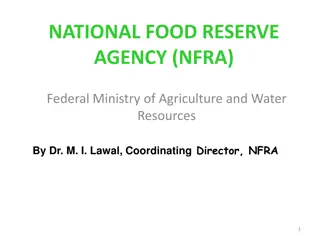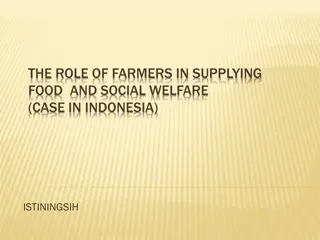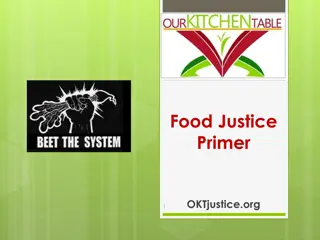Understanding Food Security and Social Welfare Administration
Food security is crucial for ensuring all individuals have access to enough nutritious food for an active, healthy life. Social welfare policies such as MNREGA play a vital role in addressing food security issues globally. The concepts of household food security, resilience to supply disruptions, and the importance of adequate food supply are discussed in the context of global challenges and specific concerns within India. Efforts to tackle undernutrition and enhance protein intake are highlighted, emphasizing the need for comprehensive approaches to ensure food security for all.
Download Presentation

Please find below an Image/Link to download the presentation.
The content on the website is provided AS IS for your information and personal use only. It may not be sold, licensed, or shared on other websites without obtaining consent from the author. Download presentation by click this link. If you encounter any issues during the download, it is possible that the publisher has removed the file from their server.
E N D
Presentation Transcript
Social Welfare Policies To Food Security MNREGA
To Food Security Food security is a measure of the availability of food and individuals' ability to access it. Affordability is only one factor. There is evidence of food security being a concern many thousands of years ago, with central authorities in ancient China and ancient Egypt being known to release food from storage in times of famine. At the 1974 World Food Conference the term "food security" was defined with an emphasis on supply. They said food security is the "availability at all times of adequate, nourishing, diverse, balanced and moderate world food supplies of basic foodstuffs to sustain a steady expansion of food consumption and to offset fluctuations in production and prices". Later definitions added demand and access issues to the definition. The final report of the 1996 World Food Summit states that food security "exists when all people, at all times, have physical and economic access to sufficient, safe and nutritious food to meet their dietary needs and food preferences for an active and healthy life. ".
Household food security exists when all members, at all times, have access to enough food for an active, healthy life. Individuals who are food secure do not live in hunger or fear of starvation. Food insecurity, on the other hand, is defined by the United States Department of Agriculture (USDA) as a situation of "limited or uncertain availability of nutritionally adequate and safe foods or limited or uncertain ability to acquire acceptable foods in socially acceptable ways". Food security incorporates a measure of resilience to future disruption or unavailability of critical food supply due to various risk factors including droughts, shipping disruptions, fuel shortages, economic instability, and wars. In the years 2011 2013, an estimated 842 million people were suffering from chronic hunger. The Food and Agriculture Organization of the United Nations, or FAO, identified the four pillars of food security as availability, access, utilization, and stability. The United Nations (UN) recognized the Right to Food in the Declaration of Human Rights in 1948, an d has since said that it is vital for the enjoyment of all other rights.
The 1996 World Summit on Food Security declared that "food should not be used as an instrument for political and economic pressure". Food security entails ensuring adequate food supply to people, especially those who are deprived of basic nutrition. Food security has been a major concern in India. According to UN-India, there are nearly 195 million undernourished people in India, which is a quarter of the world's hunger burden. Also roughly 43% children in India are chronically undernourished. India ranks 74 out of 113 major countries in terms of food security index. Though the available nutritional standard is 100% of the requirement, India lags far behind in terms of quality protein intake at 20% which needs to be tackled by making available protein rich food products such as eggs, meat, fish, chicken, etc. at affordable prices.
Laws In order to provide the Right to food to every citizen of the country, the Parliament of India, enacted a legislation in 2013 known as the National Food Security Act, 2013. Also called as the Right to Food Act, this Act seeks to provide subsidized food grains to approximately two thirds of India's 1.33 billion population. It was signed into law on 12 September 2013, retroactive to 5 July 2013. Schemes by government Central Initiatives The National Food Security Act,2013 (NFSA 2013) converts into legal entitlements for existing food security programmes of the Government of India. It includes the Midday Meal Scheme, Integrated Child Development Services scheme and the Public Distribution System. In 2017-18, over Rs 1500 billion (7.6% of the government's total expenditure) have been allocated to provide food subsidies under the Targeted Public Distribution System (TPDS). The NFSA 2013 also recognizes maternity entitlements. Pregnant women, lactating mothers, and certain categories of children are eligible for daily free cereals.
State Initiatives Karnataka has launched 'Indira Canteen', which serves breakfast lunch and dinner at very low price. This scheme was brought by Congress govt led by Siddaramaiah as CM so that no-one in the state should is hungry and everyone gets a healthy food. Tamil Nadu has launched 'Amma Unavagam' (Mother's canteen), or more commonly known as Amma canteen. The genesis of this program could be traced to the scheme proposed by Nimbkar Agricultural Research Institute in 2012. The State of UP in 2013 passed a food bill. Food that is going to be wasted from parties will be preserved and distributed to poor and needy people. The Chhattisgarh Food Security Act, 2012 law was enacted by the Chhattisgarh government. It was passed on 21 December 2012, by the State Assembly unopposed to ensure "access to adequate quantity of food and other requirements of good nutrition to the people of the State, at affordable prices, at all times to live a life of dignity.
In the country of India, food availability is not that reliable. Their population right now is 1.3 billion and by 2030, it is estimated that their population will increase to 1.5 billion. The challenge to produce more and more for the growing population is becoming increasingly hard for a country of its size and economic growth. Since the land in India is a shrinking resource for agriculture, the production rate for agriculture needs to be higher per unit of land and irrigation water. Over 60% of the Indian population depend on the agriculture for their daily meals. India produces around 100 million tonnes of rice every year. To access food in India can be considered as not as easy as Australia. It is really hard to get hands on fresh fruit and vegetables. While there might be enough food for the whole population of India, many families and especially children in India don't have access to food because of financial problems. Thus, this is the cause of millions of malnourished children around India. The cultural knowledge in India allows them to have a very nutritional and balanced diet. Nearly the whole of the Indian population have rice at least once a day which allows them to have carbohydrates in their system. Since India is most commonly known for producing and exporting rice to other countries, their lifestyle will be mainly dominated by rice.
Technological solutions India needs to concentrate on methods to improve the availability and affordability of protein rich food products using the latest environmental friendly technology without the need of additional land and water. Biogas or natural gas or methane produced from farm/agro/crop/domestic waste can also be used in addition to mined natural gas for producing protein rich cattle/fish/poultry/pet animal feed economically by cultivating Methylococcus capsulatus bacteria culture in a decentralized manner near to the rural / consumption areas with tiny land and water foot print.
Mahatma Gandhi Employment Guarantee Act Mahatma Gandhi Employment Guarantee Act 2005 (the "Mahatma Gandhi National Rural Employment Guarantee Act", MGNREGA), is an Indian labour law and social security measure that aims to guarantee the 'right to work'. This act was passed in September 2005. It aims to enhance livelihood security in rural areas by providing at least 100 days of wage employment in a financial year to every household whose adult members volunteer to do unskilled manual work. The act was first proposed in 1991 by P.V. Narasimha Rao. It was finally accepted in the parliament and commenced implementation in 625 districts of India. Based on this pilot experience, NREGA was scoped up to cover all the districts of India from 1 April 2008. The statute is hailed by the government as "the largest and most ambitious social security and public works programme in the world". In its World Development Report 2014, the World Bank termed it a "stellar example of rural development".
The MGNREGA was initiated with the objective of "enhancing livelihood security in rural areas by providing at least 100 days of guaranteed wage employment in a financial year, to every household whose adult members volunteer to do unskilled manual work". Another aim of MGNREGA is to create durable assets (such as roads, canals, ponds and wells). Employment is to be provided within 5 km of an applicant's residence, and minimum wages are to be paid. If work is not provided within 15 days of applying, applicants are entitled to an unemployment allowance. That is, if the government fails to provide employment, it has to provide certain unemployment allowances to those people. Thus, employment under MGNREGA is a legal entitlement. MGNREGA is to be implemented mainly by Gram Panchayats (GPs). The involvement of contractors is banned. Apart from providing economic security and creating rural assets, NREGA can help in protecting the environment, empowering rural women, reducing rural-urban migration and fostering social equity, among others." The law provides many safeguards to promote its effective management and implementation. The act explicitly mentions the principles and agencies for implementation, list of allowed works, financing pattern, monitoring and evaluation, and most importantly the detailed measures to ensure transparency and accountability.
History From 1960, the first 30 years of experimentation with employment schemes in rural areas taught few important lessons to the government like the Rural Manpower Programme taught the lesson of financial management, the Crash Scheme for Rural Employment of planning for outcomes, a Pilot Intensive Rural Employment Programme of labour-intensive works, the Drought Prone Area Programme of integrated rural development, Marginal Farmers and Agricultural Labourers Scheme of rural economic development, the Food for Work Programme (FWP) of holistic development and better coordination with the states, the National Rural Employment Programme (NREP) of community development, and the Rural Landless Employment Guarantee Programme of focus on landless households. The Planning Commission later approved the scheme and the same was adopted on national scale. On 1 April 1989, to converge employment generation, infrastructure development and food security in rural areas, the government integrated NREP and RLEGP into a new scheme JRY. The most significant change was the decentralization of implementation by involving the local people through PRIs and hence a decreasing role of bureaucracy.
On 2 October 1993, the Employment Assurance Scheme (EAS) was initiated by the then prime minister P.V.Narasimha Rao to provide employment to agricultural hands during the lean agricultural season. Rao had started discussions on this act in the year 1991. The role of PRIs was reinforced with the local self-government at the district level called the Zilla Parishad as the main implementing authority. Later, EAS was merged with SGRY in 2001. On 1 April 1999, the JRY was revamped and renamed to JGSY with a similar objective. The role of PRIs was further reinforced with the local self-government at the village level called the Village Panchayats as the sole implementing authority. In 2001, it was merged with SGRY. In January 2001, the government introduced FWP (Food for Work Programme) similar to the one that was initiated in 1977. Once NREGAwas enacted, the two were merged in 2006.
On 25 September 2001 to converge employment generation, infrastructure development and food security in rural areas, the government integrated EAS and JGSY into a new scheme SGRY. The role of PRIs was retained with the Village Panchayats as the sole implementing authority. Yet again due to implementation issues, it was merged with Mahatma Gandhi NREGA in 2006. The total government allocation to these precursors of Mahatma Gandhi NREGA had been about three-quarters of 1 trillion (US$14 billion).
Overview According to the Eleventh Five Year Plan (2007 12), the number of Indians living on less than $1 a day, called Below Poverty Line (BPL), was 300 million that barely declined over the last three decades ranging from 1973 to 2004, although their proportion in the total population decreased from 36 per cent (1993 94) to 28 percent (2004 05), and the rural working class dependent on agriculture was unemployed for nearly 3 months per year. The uco Government had planned to increase the number of working days from 100 to 150 before the 2014 Lok Sabha Elections in the country but failed. The NDAgovernment has decided to provide 150 days for rain hit areas. The registration process involves an application to the Gram Panchayat and issue of job cards. The wage employment must be provided within 15 days of the date of application. The work entitlement of 120 days per household per year may be shared between different adult members of the same household.
The law also lists permissible works: water conservation and water harvesting; drought proofing including afforestation; irrigation works; restoration of traditional water bodies; land development; flood control; rural connectivity; and works notified by the government. The Act sets a minimum limit to the wage-material ratio as 60:40. The provision of accredited engineers, worksite facilities and a weekly report on worksites is also mandated by theAct. Furthermore, the Act sets a minimum limit to the wages, to be paid with gender equality, either on a time-rate basis or on a piece-rate basis. The states are required to evolve a set of norms for the measurement of works and schedule of rates. Unemployment allowance must be paid if the work is not provided within the statutory limit of 15 days. The law stipulates Gram Panchayats to have a single bank account for NREGA works which shall be subjected to public scrutiny. To promote transparency and accountability, the act mandates monthly squaring of accounts . To ensure public accountability through public vigilance, the NREGA designates social audits as key to its implementation.
The most detailed part of the Act (chapter 10 and 11) deals with transparency and accountability that lays out role of the state, the public vigilance and, above all, the social audits. For evaluation of outcomes, the law also requires management of data and maintenance of records, like registers related to employment, job cards, assets, muster rolls and complaints, by the implementing agencies at the village, block and state level. The legislation specifies the role of the state in ensuring transparency and accountability through upholding the right to information and disclosing information proactively, preparation of annual reports by CEGC for Parliament and SEGCs for state legislatures, undertaking mandatory financial audit by each district along with physical audit, taking action on audit reports, developing a Citizen's Charter, establishing vigilance and monitoring committees, and developing grievance redressal system.
The Act recommends establishment of Technical Resource Support Groups at district, state and central level and active use of Information Technology, like creation of a Monitoring and Information System (MIS) and a NREGA website, to assure quality in implementation of NREGA through technical support. The law allows convergence of NREGA with other programmes. As NREGA intends to create additional employment, the convergence should not affect employment provided by other programmes.
The law and the Constitution of India The Act aims to follow the Directive Principles of State Policy enunciated in Part IV of the Constitution of India. The law by providing a 'right to work' is consistent with Article 41 that directs the State to secure to all citizens the right to work. The statute also seeks to protect the environment through rural works which is consistent with Article 48A that directs the State to protect the environment. In accordance with the Article 21 of the Constitution of India that guarantees the right to life with dignity to every citizen of India, this act imparts dignity to the rural people through an assurance of livelihood security. The Fundamental Right enshrined in Article 16 of the Constitution of India guarantees equality of opportunity in matters of public employment and prevents the State from discriminating against anyone in matters of employment on the grounds only of religion, race, caste, sex, descent, place of birth, place of residence or any of them. NREGA also follows Article 46 that requires the State to promote the interests of and work for the economic uplift of the scheduled castes and scheduled tribes and protect them from discrimination and exploitation.
Article 40 mandates the State to organise village panchayats and endow them with such powers and authority as may be necessary to enable them to function as units of self-government. Conferring the primary responsibility of implementation on Gram Panchayats, the Act adheres to this constitutional principle. Also the process of decentralization initiated by 73rd Amendment to the Constitution of India that granted a constitutional status to the Panchayats is further reinforced by the Mahatma Gandhi NREGA that endowed these rural self-government institutions with authority to implement the law.























